Embark on a journey through the lush landscapes of Wisconsin with our comprehensive photo guide dedicated to the blue birds of the region. From the charismatic Eastern Bluebird to the striking Blue-winged Warbler, Wisconsin is home to an array of blue birds, each with its own unique characteristics and habitats.
Whether you are a seasoned birdwatcher or a beginner looking to dive into the world of avian wonders, this guide will provide you with all the information you need to identify and appreciate the blue birds in Wisconsin.
Blue Birds Found In Wisconsin
The state of Wisconsin is characterized by its varied geography, which includes a mix of forests, wetlands, and grasslands. This wide range of habitats provides the perfect environment for a diverse range of birds to thrive. The abundant water bodies attract waterfowl and shorebirds, while the extensive forests are home to many songbirds and raptors.
Wisconsin’s location along the migratory path of many bird species makes it a hotspot for bird watching, as birds pass through during their seasonal migrations. This diverse range of habitats and geographic location make Wisconsin home to a vast array of bird species, including many varieties of blue birds.
Eastern Bluebird
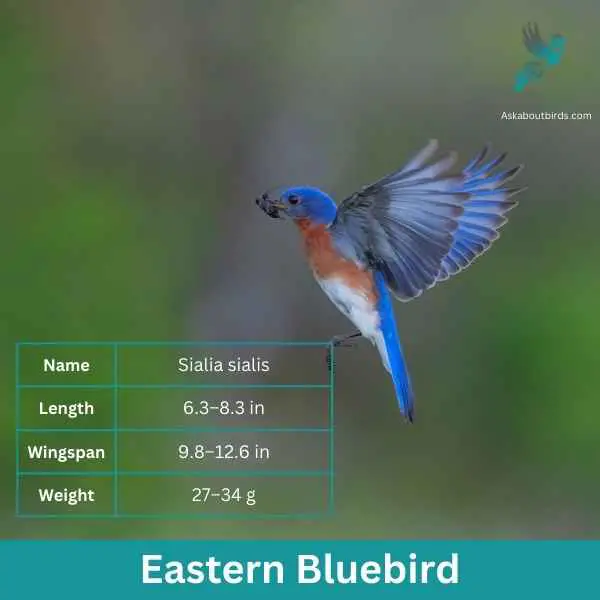
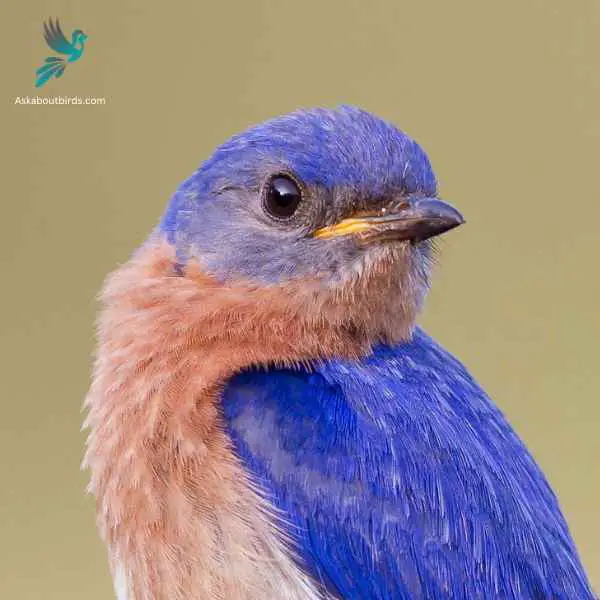
| Feature | Measurement |
|---|---|
| Scientific Name | Sialia sialis |
| Length | 6.3–8.3 in |
| Wingspan | 9.8–12.6 in |
| Weight | 27–34 g |
The Eastern Bluebird (Sialia sialis) is a small thrush found in open woodlands, farmlands, and orchards, and is recognized for its vibrant blue and red coloration. Male Eastern Bluebirds are dazzling with bright blue upperparts and a rusty or brick-red throat and breast, while females, though less colorful, still offer a similar pattern. The bird is native to North America and is commonly seen east of the Rockies, from Canada to the Gulf States and southeastern Arizona to Nicaragua.
Eastern Bluebirds feed on insects, wild fruit and berries. They have a gentle nature and are often seen perched alone or in small groups in the open, scanning the ground for prey. They are cavity nesters and will use old woodpecker holes or birdhouses if they are the right size.
Indigo Bunting


| Feature | Measurement |
|---|---|
| Scientific Name | Passerina cyanea |
| Length | 4.5–5.1 in |
| Wingspan | 7.1–9.1 in |
| Weight | 11.2–21.4 g |
The Indigo Bunting is a strikingly vibrant songbird, often hailed for its brilliant blue plumage and melodic song that graces woodlands and meadows during the warmer months.
Appearance: Males are renowned for their bright indigo blue feathers, which can appear darker in certain lights. Females and juveniles, on the other hand, are brown with subtle hints of blue on their wings and tail. The species lacks the vibrant streaking or spotting commonly found in many other songbirds.
Diet: Indigo Buntings primarily subsist on seeds, especially during non-breeding seasons. During the breeding season, they also consume a variety of insects such as beetles, caterpillars, and spiders, providing essential protein for their growing chicks.
Reproduction: Indigo Buntings build their nests close to the ground in shrubs or low tree branches. These nests, crafted meticulously with grasses and other plant materials, cradle clutches of typically 3 to 4 eggs. After hatching, the young are fed by both parents until they’re ready to fledge.
Blue Jay

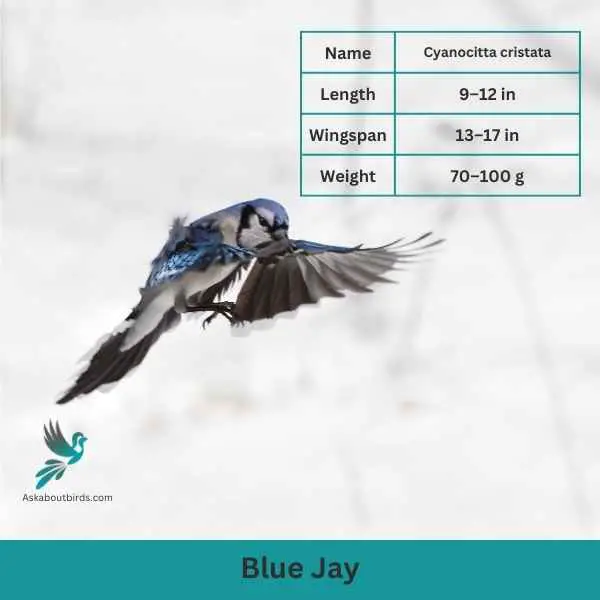
| Feature | Measurement |
|---|---|
| Scientific Name | Cyanocitta cristata |
| Length | 9–12 in |
| Wingspan | 13–17 in |
| Weight | 70–100 g |
The Blue Jay is a vibrant and easily recognized bird, known for its intelligence, distinctive calls, and bold behavior, commonly found throughout the eastern and central United States.
Appearance: The Blue Jay sports a striking blue upper body with white and black markings. Its face has a pronounced white patch with a black necklace that runs across the throat and around the head. The bird also features a pronounced blue crest, which can be raised or lowered, and its wings and tail are brightly colored with black bars and white tips.
Diet: Blue Jays are omnivores. Their diet consists primarily of seeds, nuts, especially acorns, fruits, and small insects. They’ve also been known to eat eggs or nestlings of other birds occasionally. Blue Jays often store food items in caches to eat later.
Reproduction: Blue Jays are monogamous birds that form long-lasting pair bonds. They typically build their nests in trees or large shrubs, constructing them from twigs, grass, and sometimes using mud as a binder. The female lays a clutch of 3 to 6 eggs, which are pale blue or sometimes white with brown speckles.
Tree Swallow
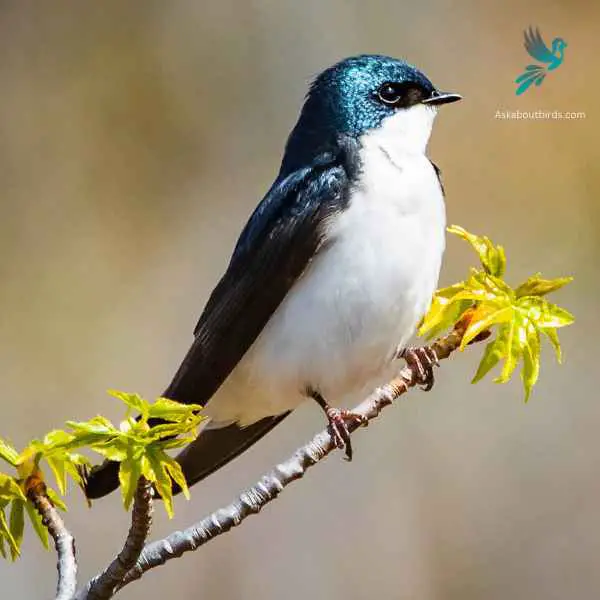
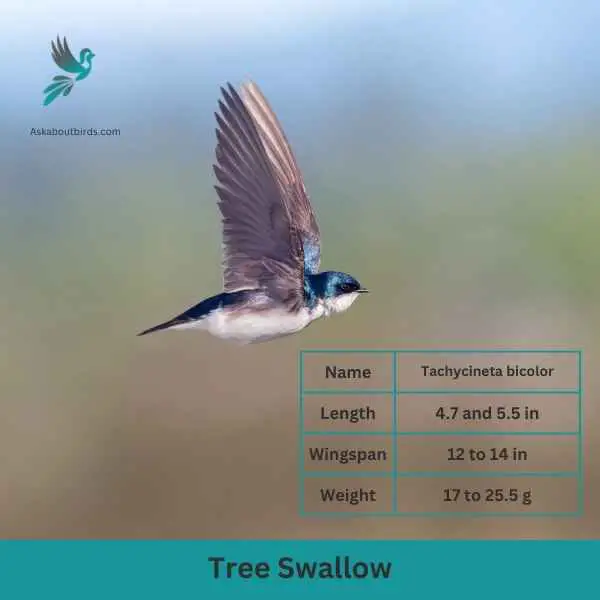
| Feature | Measurement |
|---|---|
| Scientific Name | Tachycineta bicolor |
| Length | 4.7 and 5.5 in |
| Wingspan | 12 to 14 in |
| Weight | 17 to 25.5 g |
The Tree Swallow is a graceful and agile bird, best recognized for its iridescent blue-green upperparts and sweeping flight patterns over open fields and water.
Appearance: The Tree Swallow is sleek with a streamlined body. The upperparts shine with a blue-green iridescence while the underparts are white. They possess long, pointed wings and a slightly forked tail, aiding in their agile flight.
Diet: Tree Swallows primarily feed on flying insects, skillfully catching them mid-air. During colder months when insects are scarce, they can switch to a diet of berries, particularly those of the bayberry, which other birds might find hard to digest.
Reproduction: Tree Swallows are cavity-nesters, typically choosing natural holes in trees or using bird boxes. They line their nests with feathers, creating a soft environment for the eggs. The female will lay a clutch of 4 to 7 white eggs.
Belted Kingfisher

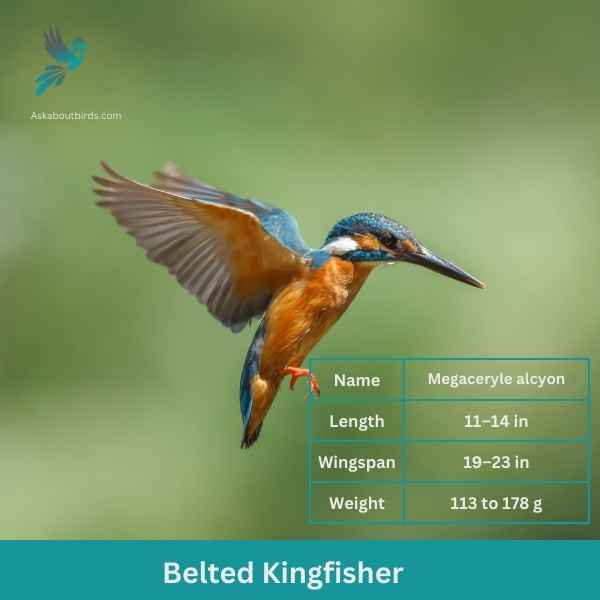
| Feature | Measurement |
|---|---|
| Scientific Name | Megaceryle alcyon |
| Length | 11–14 in |
| Wingspan | 19–23 in |
| Weight | 113 to 178 g |
The Belted Kingfisher is a distinctive and easily recognizable bird, frequently observed near water bodies, where it can be seen diving headfirst to catch prey.
Appearance: Sporting a prominent crest, the Belted Kingfisher has a slate blue-gray upper body and white underparts. Males possess a single blue band across their white chests, while females have an additional rufous band, making them one of the few bird species where females are more brightly colored than males. Their bill is long, sharp, and dagger-like.
Diet: As expert fishers, Belted Kingfishers mainly prey on small fish, but they’ll also consume crustaceans, insects, and amphibians. They’re known for their hunting tactic of hovering over water, spotting their prey, and then diving swiftly to snatch it.
Reproduction: Belted Kingfishers nest in burrows which they excavate in sandy or earthen banks, usually adjacent to water. The tunnel can be anywhere from 3 to 6 feet long, ending in a chamber. Within this chamber, the female lays a clutch of 5 to 8 white eggs.
Barn Swallow


| Feature | Measurement |
|---|---|
| Scientific Name | Hirundo rustica |
| Length | 6.5–7.5 in |
| Wingspan | 12.5–13.5 in |
| Weight | 16–22 g |
The Barn Swallow is a sleek, agile bird renowned for its graceful flight patterns and iconic forked tail, often seen darting over fields and water bodies in search of flying insects.
Appearance: Barn Swallows have deep blue, almost iridescent, upperparts and a rufous to tawny underbelly. Their distinctively forked tail and long wings give them a streamlined look. Both males and females have a similar appearance, though males often exhibit slightly brighter colors and a deeper fork in the tail.
Diet: Barn Swallows feed primarily on flying insects, which they catch in mid-air during their agile and acrobatic flights. Their diet includes flies, beetles, moths, and other small flying insects.
Reproduction: Barn Swallows are known for building their mud nests on man-made structures, particularly barns, bridges, and eaves. The nest is cup-shaped and made from mud pellets, often lined with feathers. The female lays a clutch of 4 to 6 eggs.
Blue Grosbeak
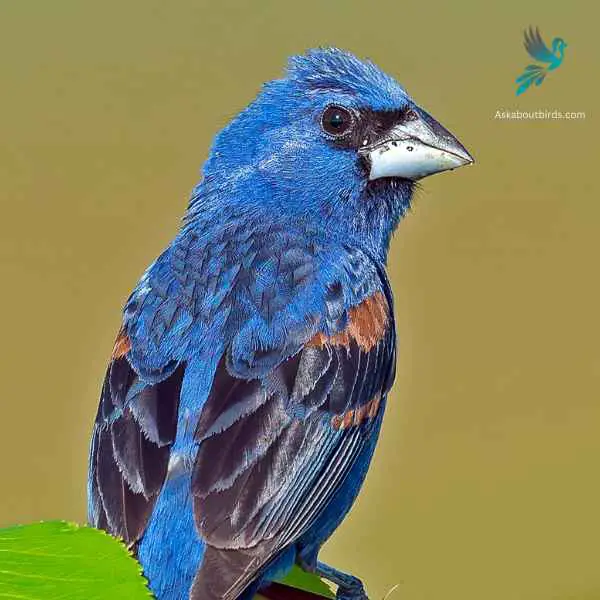

| Feature | Measurement |
|---|---|
| Scientific Name | Passerina caerulea |
| Length | 5.5 to 7.5 in |
| Wingspan | 10 to 11 in |
| Weight | 26 to 31.5 g |
The Blue Grosbeak is a medium-sized songbird found in North and Central America. The male Blue Grosbeak displays stunning plumage with deep blue feathers on its body and head, while the female has more subdued brownish tones. Both sexes have a thick, conical bill, which gives them their name “grosbeak,” meaning large beak.
These birds prefer open habitats such as grasslands, brushy areas, and woodland edges. Blue Grosbeaks are known for their melodious songs, which consist of a series of rich and varied notes. They primarily feed on seeds and insects, using their strong beaks to crack open seeds and forage on the ground or in low vegetation.
Blue-headed Vireo
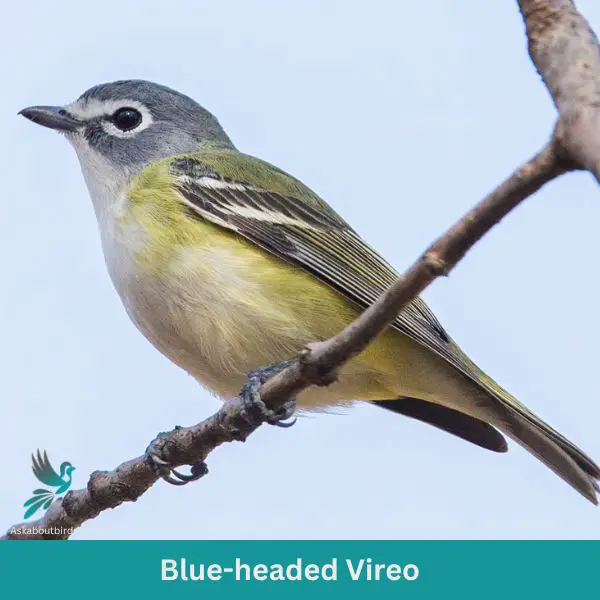
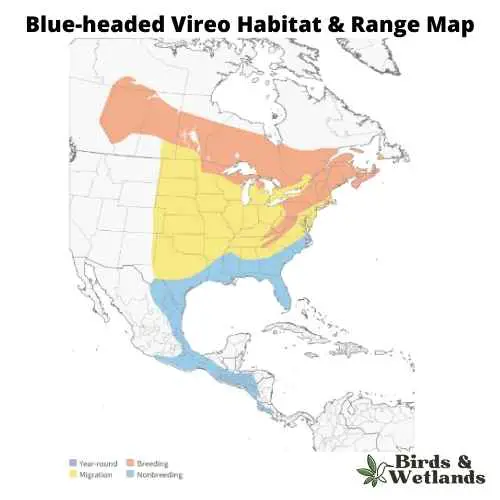
| Trait | Blue-headed Vireo |
|---|---|
| Scientific Name | Vireo solitarius |
| Length | 5-5.5 inches |
| Wingspan | 7.9-9.8 inches |
| Weight | 0.4-0.6 ounces |
The Blue-headed Vireo is a songbird recognized for its sharp and clear song as well as its distinct coloration.
Appearance: It has a blue-gray head and nape, contrasting sharply with its white throat and belly. A white eye ring combined with two white wing bars and yellowish flanks further accentuate its appearance.
Diet: The Blue-headed Vireo feeds mainly on insects and spiders. It often forages in the forest canopy, picking prey off leaves and twigs.
Reproduction: The female constructs a cup-shaped nest made of twigs, bark, and spiderwebs, often placed in the fork of a tree branch. Typically, she lays a clutch of 3-5 eggs. Both parents share the responsibility of incubating the eggs and feeding the chicks.
Blue-winged Warbler
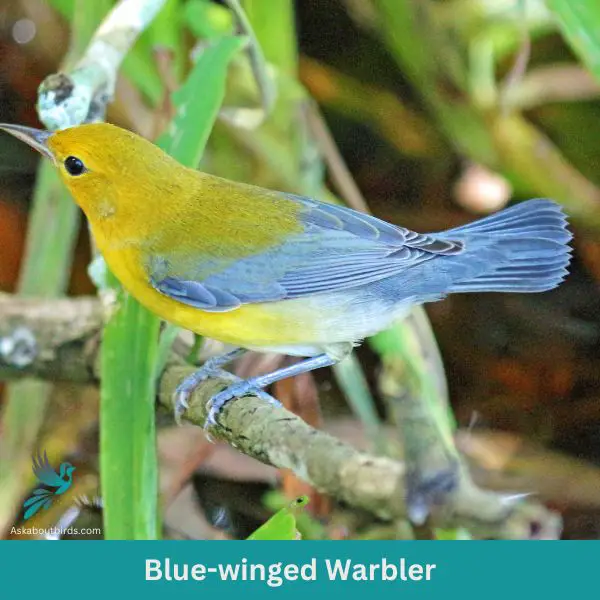
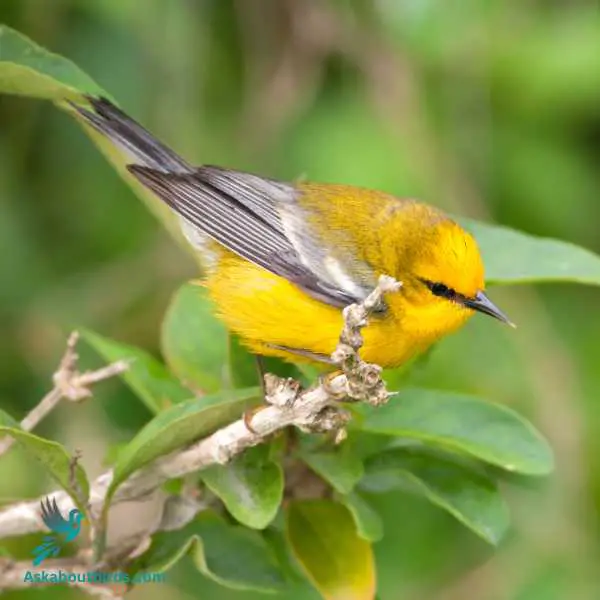
| Trait | Blue-winged Warbler |
|---|---|
| Scientific Name | Vermivora cyanoptera |
| Length | 4.3-4.7 inches |
| Wingspan | 6.7-7.5 inches |
| Weight | 0.3-0.4 ounces |
The Blue-winged Warbler is a vibrant songbird that stands out with its lemon-yellow coloring and buzzing song.
Appearance: This warbler displays a brilliant yellow body contrasted by blue-gray wings and a slim, black line through the eyes. The wings also feature two white wing bars.
Diet: The diet of the Blue-winged Warbler primarily consists of insects and spiders. They actively forage in shrubs and low trees, picking off their prey from the foliage.
Reproduction: Blue-winged Warblers build their nests on or near the ground, using grasses and other fine materials. The female lays a clutch of 4-6 eggs, which she incubates.
Where to Spot Wisconsin’s Blue Birds
Wisconsin is a haven for birdwatchers, with its diverse habitats hosting a multitude of bird species. Here are some top spots for birdwatching, especially for those on the lookout for the magnificent blue birds:
- Horicon Marsh: This is the largest freshwater cattail marsh in the United States, making it a prime location for spotting a variety of bird species, including blue birds like the Indigo Bunting and Eastern Bluebird.
- Crex Meadows: A vast area of wetlands, brush prairies, and forests that provide a habitat for a wide variety of wildlife, including the Blue-winged Warbler and Blue Jay.
- Point Pelee National Park: Although it is technically in Canada, it is easily accessible from Wisconsin and is one of the best places in North America to observe migrating birds, including the beautiful Blue-headed Vireo.
- Chequamegon-Nicolet National Forest: This national forest offers a vast expanse of woodlands, home to many forest-dwelling birds such as the Cerulean Warbler and Black-capped Chickadee.
- Apostle Islands National Lakeshore: Located on the shore of Lake Superior, this area provides a unique habitat for birds like the Belted Kingfisher and Tree Swallow.
| State’s Blue Birds | Best Spots for Blue Birds |
|---|---|
| Iowa’s Blue Birds | 1. Neal Smith National Wildlife Refuge 2. Ledges State Park 3. Lake Red Rock |
| Minnesota’s Blue Birds | 1. Tamarac National Wildlife Refuge 2. Sax-Zim Bog 3. Agassiz National Wildlife Refuge |
| Michigan’s Blue Birds | 1. Seney National Wildlife Refuge 2. Sleeping Bear Dunes National Lakeshore 3. Pointe Mouillee State Game Area |
| Illinois’s Blue Birds | 1. Starved Rock State Park 2. Montrose Point Bird Sanctuary 3. Cache River State Natural Area |
FAQs on Blue Bird Species Found in Wisconsin
What Are Some Common Blue Colored Birds?
Common blue colored birds include the Indigo Bunting, male Eastern Bluebird, and Blue-gray Gnatcatcher. The Indigo Bunting is a small bird with bright blue plumage during the breeding season, while the male Eastern Bluebird has a bright blue back and white belly. The Blue-gray Gnatcatcher, on the other hand, another blue colored bird that has a bluish-gray plumage. Other blue beauties include the Black-throated Blue Warblers and Cerulean Warblers, both of which are small warblers with striking blue plumage.
Do Purple Martins Migrate?
Yes, Purple Martins do migrate. They are social birds that breed in North America and then migrate south to Central and South America for the winter. Large flocks of Purple Martins can be seen flying south in late summer and early fall. These birds depend on human-provided nesting boxes in many parts of North America, and their migration patterns can be affected by the availability of suitable nesting sites. Cornell Lab and other organizations provide range maps that can help birdwatchers track their migration.
Why Are Male Indigo Buntings Sky Blue?
Male Indigo Buntings are known for their vibrant sky blue plumage, which is especially prominent during the breeding season. This brilliant coloration is a result of the way the structure of their feathers interacts with light, rather than pigmentation. The feathers of the male Indigo Bunting scatter light in a way that our eyes perceive as bright blue. Interestingly, outside of the breeding season, males molt into a more subdued, brownish plumage that helps them blend into their environment.
How Can I Help With Bluebird Conservation?
Bluebird conservation is crucial to ensure the survival of a dozen species of beautiful birds. Start by setting up a bluebird nest box and bird feeder in your yard, as this provides a safe space for them to lay eggs and raise their young. Regularly monitor the nest box to protect young birds from predators like house sparrows and European starlings. Additionally, providing bird feeders with sunflower seeds can also be beneficial. Joining a bluebird conservation group and participating in citizen science projects can also make a significant impact.


